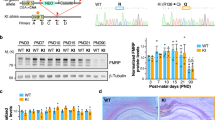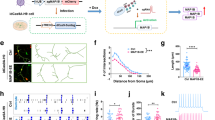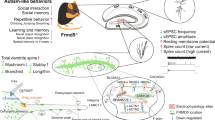Abstract
Fragile X syndrome is caused by the loss of Fragile X mental retardation protein (FMRP), an RNA-binding protein that suppresses protein translation. We found that FMRP binds to Down syndrome cell adhesion molecule (Dscam) RNA, a molecule that is involved in neural development and has been implicated in Down syndrome. Elevated Dscam protein levels in FMRP null Drosophila and in flies with three copies of the Dscam gene both produced specific and similar synaptic targeting errors in a hard-wired neural circuit, which impaired the flies' sensory perception. Reducing Dscam levels in FMRP null flies reduced synaptic targeting errors and rescued behavioral responses. Our results indicate that excess Dscam protein may be a common molecular mechanism underlying altered neural wiring in intellectual disabilities such as Fragile X and Down syndromes.
This is a preview of subscription content, access via your institution
Access options
Subscribe to this journal
Receive 12 print issues and online access
$209.00 per year
only $17.42 per issue
Buy this article
- Purchase on Springer Link
- Instant access to full article PDF
Prices may be subject to local taxes which are calculated during checkout





Similar content being viewed by others
References
Rachidi, M. & Lopes, C. Mental retardation in Down syndrome: from gene dosage imbalance to molecular and cellular mechanisms. Neurosci. Res. 59, 349–369 (2007).
Bassell, G.J. & Warren, S.T. Fragile X syndrome: loss of local mRNA regulation alters synaptic development and function. Neuron 60, 201–214 (2008).
Ascano, M. Jr. et al. FMRP targets distinct mRNA sequence elements to regulate protein expression. Nature 492, 382–386 (2012).
Brown, V. et al. Microarray identification of FMRP-associated brain mRNAs and altered mRNA translational profiles in fragile X syndrome. Cell 107, 477–487 (2001).
Darnell, J.C. et al. FMRP stalls ribosomal translocation on mRNAs linked to synaptic function and autism. Cell 146, 247–261 (2011).
Takashima, S., Becker, L.E., Armstrong, D.L. & Chan, F. Abnormal neuronal development in the visual cortex of the human fetus and infant with Down's syndrome. A quantitative and qualitative Golgi study. Brain Res. 225, 1–21 (1981).
Antonarakis, S.E. 10 years of genomics, chromosome 21 and Down syndrome. Genomics 51, 1–16 (1998).
Yamakawa, K. et al. DSCAM: a novel member of the immunoglobulin superfamily maps in a Down syndrome region and is involved in the development of the nervous system. Hum. Mol. Genet. 7, 227–237 (1998).
Korenberg, J.R. et al. Down syndrome phenotypes: the consequences of chromosomal imbalance. Proc. Natl. Acad. Sci. USA 91, 4997–5001 (1994).
Barlow, G.M. et al. Down syndrome congenital heart disease: a narrowed region and a candidate gene. Genet. Med. 3, 91–101 (2001).
Hildmann, T. et al. A contiguous 3-Mb sequence-ready map in the S3-MX region on 21q22.2 based on high- throughput nonisotopic library screenings. Genome Res. 9, 360–372 (1999).
Alves-Sampaio, A., Troca-Marin, J.A. & Montesinos, M.L. NMDA-mediated regulation of DSCAM dendritic local translation is lost in a mouse model of Down's syndrome. J. Neurosci. 30, 13537–13548 (2010).
Schmucker, D. & Chen, B. Dscam and DSCAM: complex genes in simple animals, complex animals yet simple genes. Genes Dev. 23, 147–156 (2009).
Ghysen, A. The projection of sensory neurons in the central nervous system of Drosophila: choice of the appropriate pathway. Dev. Biol. 78, 521–541 (1980).
Chen, B.E. et al. The molecular diversity of Dscam is functionally required for neuronal wiring specificity in Drosophila. Cell 125, 607–620 (2006).
Neufeld, S.Q., Hibbert, A.D. & Chen, B.E. Opposing roles of PlexinA and PlexinB in axonal branch and varicosity formation. Mol. Brain 4, 15 (2011).
Hinz, U., Giebel, B. & Campos-Ortega, J.A. The basic-helix-loop-helix domain of Drosophila lethal of scute protein is sufficient for proneural function and activates neurogenic genes. Cell 76, 77–87 (1994).
Ashley, C.T. Jr., Wilkinson, K.D., Reines, D. & Warren, S.T. FMR1 protein: conserved RNP family domains and selective RNA binding. Science 262, 563–566 (1993).
Bagni, C. & Greenough, W.T. From mRNP trafficking to spine dysmorphogenesis: the roots of fragile X syndrome. Nat. Rev. Neurosci. 6, 376–387 (2005).
Zalfa, F. et al. A new function for the fragile X mental retardation protein in regulation of PSD-95 mRNA stability. Nat. Neurosci. 10, 578–587 (2007).
Didiot, M.C. et al. The G-quartet containing FMRP binding site in FMR1 mRNA is a potent exonic splicing enhancer. Nucleic Acids Res. 36, 4902–4912 (2008).
Canal, I., Acebes, A. & Ferrus, A. Single neuron mosaics of the Drosophila gigas mutant project beyond normal targets and modify behavior. J. Neurosci. 18, 999–1008 (1998).
Corfas, G. & Dudai, Y. Habituation and dishabituation of a cleaning reflex in normal and mutant Drosophila. J. Neurosci. 9, 56–62 (1989).
Phillis, R.W. et al. Isolation of mutations affecting neural circuitry required for grooming behavior in Drosophila melanogaster. Genetics 133, 581–592 (1993).
Vandervorst, P. & Ghysen, A. Genetic control of sensory connections in Drosophila. Nature 286, 65–67 (1980).
Darnell, J.C., Fraser, C.E., Mostovetsky, O. & Darnell, R.B. Discrimination of common and unique RNA-binding activities among Fragile X mental retardation protein paralogs. Hum. Mol. Genet. 18, 3164–3177 (2009).
Darnell, J.C. et al. Kissing complex RNAs mediate interaction between the Fragile-X mental retardation protein KH2 domain and brain polyribosomes. Genes Dev. 19, 903–918 (2005).
Schmucker, D. et al. Drosophila Dscam is an axon guidance receptor exhibiting extraordinary molecular diversity. Cell 101, 671–684 (2000).
Margulies, M. et al. Genome sequencing in microfabricated high-density picolitre reactors. Nature 437, 376–380 (2005).
Li, H.L. et al. Dscam mediates remodeling of glutamate receptors in Aplysia during de novo and learning-related synapse formation. Neuron 61, 527–540 (2009).
Guruharsha, K.G. et al. A protein complex network of Drosophila melanogaster. Cell 147, 690–703 (2011).
Watson, F.L. et al. Extensive diversity of Ig-superfamily proteins in the immune system of insects. Science 309, 1874–1878 (2005).
Watthanasurorot, A., Jiravanichpaisal, P., Liu, H., Soderhall, I. & Soderhall, K. Bacteria-induced Dscam isoforms of the crustacean, Pacifastacus leniusculus. PLoS Pathog. 7, e1002062 (2011).
Monzo, K. et al. Fragile X mental retardation protein controls trailer hitch expression and cleavage furrow formation in Drosophila embryos. Proc. Natl. Acad. Sci. USA 103, 18160–18165 (2006).
Stetler, A. et al. Identification and characterization of the methyl arginines in the fragile X mental retardation protein Fmrp. Hum. Mol. Genet. 15, 87–96 (2006).
Dong, Y., Taylor, H. & Dimopoulos, G. AgDscam, a hypervariable immunoglobulin domain–containing receptor of the Anopheles gambiae innate immune system. PLoS Biol. 4, e229 (2006).
Blank, M. et al. The Down syndrome critical region regulates retinogeniculate refinement. J. Neurosci. 31, 5764–5776 (2011).
Grossman, T.R. et al. Over-expression of DSCAM and COL6A2 cooperatively generates congenital heart defects. PLoS Genet. 7, e1002344 (2011).
Dierssen, M. & Ramakers, G.J. Dendritic pathology in mental retardation: from molecular genetics to neurobiology. Genes Brain Behav. 5 (suppl. 2), 48–60 (2006).
Kaufmann, W.E. & Moser, H.W. Dendritic anomalies in disorders associated with mental retardation. Cereb. Cortex 10, 981–991 (2000).
Nimchinsky, E.A., Oberlander, A.M. & Svoboda, K. Abnormal development of dendritic spines in FMR1 knock-out mice. J Neurosci 21, 5139–5146 (2001).
Dockendorff, T.C. et al. Drosophila lacking dfmr1 activity show defects in circadian output and fail to maintain courtship interest. Neuron 34, 973–984 (2002).
Bolduc, F.V., Bell, K., Cox, H., Broadie, K.S. & Tully, T. Excess protein synthesis in Drosophila fragile X mutants impairs long-term memory. Nat. Neurosci. 11, 1143–1145 (2008).
Zhang, Y.Q. et al. Drosophila fragile X-related gene regulates the MAP1B homolog Futsch to control synaptic structure and function. Cell 107, 591–603 (2001).
Parks, A.L. et al. Systematic generation of high-resolution deletion coverage of the Drosophila melanogaster genome. Nat. Genet. 36, 288–292 (2004).
Venken, K.J., He, Y., Hoskins, R.A. & Bellen, H.J. P[acman]: a BAC transgenic platform for targeted insertion of large DNA fragments in D. melanogaster. Science 314, 1747–1751 (2006).
Reeve, S.P. et al. The Drosophila fragile X mental retardation protein controls actin dynamics by directly regulating profilin in the brain. Curr. Biol. 15, 1156–1163 (2005).
Hilgers, V., Lemke, S.B. & Levine, M. ELAV mediates 3′ UTR extension in the Drosophila nervous system. Genes Dev. 26, 2259–2264 (2012).
Raj, A., van den Bogaard, P., Rifkin, S.A., van Oudenaarden, A. & Tyagi, S. Imaging individual mRNA molecules using multiple singly labeled probes. Nat. Methods 5, 877–879 (2008).
Acknowledgements
The authors thank T.-J. Lin, I. Kays and V. Stoudenikina for assistance with experiments, R. Suciu for assistance in pyrosequencing analysis, A. Staffa and the Massively Parallel Sequencing Unit at Génome Québec for pyrosequencing assistance, and B. Douba for graphic arts assistance in the fly drawing. This work was supported by an Alfred P. Sloan Research Fellowship and a Canada Research Chair grant 950-212462 (to B.E.C.) and by funds from the Department of Medicine at McGill University and the Research Institute of the McGill University Health Centre.
Author information
Authors and Affiliations
Contributions
B.E.C. designed the experiments and supervised the project. V.C., A.D.H., F.E. and B.E.C. performed the experiments and analyzed the data. V.C., F.E. and B.E.C. wrote the manuscript.
Corresponding author
Ethics declarations
Competing interests
The authors declare no competing financial interests.
Supplementary information
Supplementary Text and Figures
Supplementary Figures 1–9 (PDF 7047 kb)
Rights and permissions
About this article
Cite this article
Cvetkovska, V., Hibbert, A., Emran, F. et al. Overexpression of Down syndrome cell adhesion molecule impairs precise synaptic targeting. Nat Neurosci 16, 677–682 (2013). https://doi.org/10.1038/nn.3396
Received:
Accepted:
Published:
Issue Date:
DOI: https://doi.org/10.1038/nn.3396
This article is cited by
-
Neuronal DSCAM regulates the peri-synaptic localization of GLAST in Bergmann glia for functional synapse formation
Nature Communications (2024)
-
In Parkinson's patient-derived dopamine neurons, the triplication of α-synuclein locus induces distinctive firing pattern by impeding D2 receptor autoinhibition
Acta Neuropathologica Communications (2021)
-
16p11.2 deletion is associated with hyperactivation of human iPSC-derived dopaminergic neuron networks and is rescued by RHOA inhibition in vitro
Nature Communications (2021)
-
FGF receptors are required for proper axonal branch targeting in Drosophila
Molecular Brain (2019)
-
Inter-axonal recognition organizes Drosophila olfactory map formation
Scientific Reports (2019)



